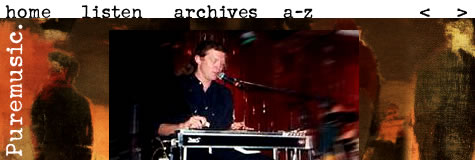
CLOTHESLINE
REVIVAL INTERVIEWS
A Conversation with Robert Powell (continued)
PM: So, not only is there great, great, fantastically creative pedal steel from you on this record, but there's baritone guitar and electric and bass and lap, also a lot of ebow work. Can you talk to us a minute about that? I myself have never used an ebow, and many of our readers may not know what it is.
RP: An ebow, which has been around for some time--you can hear it back on Robert Fripp's stuff from a long time ago--it's basically a simple plastic device that you hold in your hand, and it's got a nine volt battery in it that powers a magnet in the device. You perch this little plastic item over a string on your guitar, either an electric guitar or an acoustic guitar. If it's an electric, you've got another level of magnetism to work with because you've got magnets in the pickups. The magnet in the ebow lets the string vibrate, kind of an infinite sustain. You can get the note on a guitar to sound like a cello or a flute.
But with the subtle maneuvering of the device, depending on whether you're closer to the bridge or over a pickup, or you're pushing against the string but maybe not quite touching it, you can get into levels of harmonic distortion and harmonics on the note, like the fifth above and the octave above. So you've got all this dimension even within a single note, without even moving your fretting finger or the bar on a slide guitar or steel guitar, just by slightly maneuvering the ebow over the string. And with the pedal steel, it's particularly fluid because, let's say you're using one string and you've got the pedal on that string, you've also got all this motion within one note along with what the ebow is doing to it. It's particularly nice on the pedal steel.
PM: Wow. So between the ebow work that you're describing and the sound design that Conrad is capable of creating, it's no wonder that the atmospherics on the album are so unique. Are there any songs you want to talk about, in terms of how they came together?
RP: I'd probably need to get the album in front of me...
PM: [I start reading the titles to him.]
RP: Well, with "Cow Cow Yicky Yicky Yea, " I think the first thing I heard was just the raw recording Conrad sent me of Leadbelly from the Smithsonian Folkways recording. With that one, there's the very delicate balance between respecting Leadbelly's creation and trying to see what to do with it, how to expand on it or give another life to it by putting it in a different context. We tried a bunch of different stuff and then wound up with this pretty simple, organic thing, with Conrad adding another dimension of guitar there, and I think I put some slide guitar on that one.
On "Ramblin' Man," he had this kind of cloudy rhythmic thing going on and the vocal was already there. We just started jamming with the pedal steel, a couple of quick passes, I think with a Leslie speaker and other things, just kind of experimenting. He just took my first takes, and I think we both cut them up a little bit and edited them. From there on, he would do mixes and file them back to me, and I'd make comments. It was largely his work there, with me giving an occasional infusion.
Often there would be a sketch, and I would bring a few instruments over to his studio and start jamming and coming up with ideas with him. We would just throw it around for a while. It all went pretty quick, and that was also our intention: to keep some good fresh energy in it and not overwork it at all. So things were often first or second takes. Or make a few passes on an acoustic slide or something, just see what moved us. He has also developed all these skills, as an engineer, for getting a great sound on whatever he has recorded.
PM: Are there any other recorded projects you've been involved in, outside of Clothesline, that you'd like to turn us on to? I'm going to cover Desert Beach, which is your record--
RP: Well, yeah, check out Desert Beach--that was like '89 or '90, and I was living in Marin and "New Age," for lack of a better term, was big. I had all these sketches on guitar and slide and pedal steel, things that were either songs that didn't have lyrics or just little things that were interesting to my ear. So I went ahead and put together an instrumental album. And the intention of the album was to make a vibe that was kind of mellow and enveloping, but my preference was more for a kind of acoustic countryish thing. It's a pretty cool album, and it got great response. On All Music Review it got a five star review. Especially on certain cuts, like "Gus and Brenda" and "Delta Waves," I really feel I hit the mark of what I was going for. There are others that were more of an experiment, just trying out other possibilities. Anyway, that album also became a kind of calling card for me, getting me a lot of other sessions and opportunities to come into recordings and do something with the pedal steel that had some distinction to it. I'm working on some things now that will be a very big expansion on Desert Beach, but the same kind of thing in terms of taking the pedal steel and stretching it out, going into its essential sound rather than playing licks that've been done before. continue
jump to: Conrad
Praetzel Sukhawat
Ali Khan
Wendy Allen Tom
Armstrong
puremusic archives puremusic home